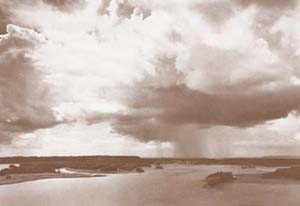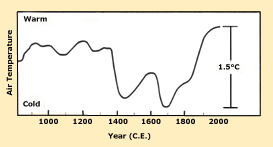
 |
| Storm over Mississippi #2 (silver gelatin print by Michael Johnson, 1982) |
There is a very great difference between this climate and that of Québec,--where the cold lasts a long time, and a great quantity of snow falls; whereas here, as a rule, the snow remains but a very short time. (Julien Binneteau, 1699)![]()
Illinois has a continental climate, which means that its winters are cold and dry and its summers are warm and wet. Early French missionaries noted, with pleasure, that the climate of the Illinois Country was milder than that of Quebec, a city located on the St. Lawrence River in what is now eastern Canada. Nevertheless, the temperatures experienced by missionaries in the Illinois Country during the late 1600s were measurably cooler than those of today. Climatologists refer to the period between A.D. 1450-1850 as the "Little Ice Age." This was an episode of relatively cool climate, when mean temperatures in the northern hemisphere dropped as much as 1.5&Mac251;C, causing glaciers to expand in mountainous regions of Europe and western North America. In some parts of North America, perhaps including Illinois, the cooler temperatures coincided with decreases in precipitation. Since 1850, average temperatures have increased and continue to rise.![]()
![]()
Generalized trends in global temperatures during the past 1,000 years.
|
|
Copyright © 2000 Illinois State Museum
